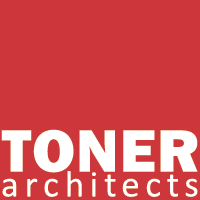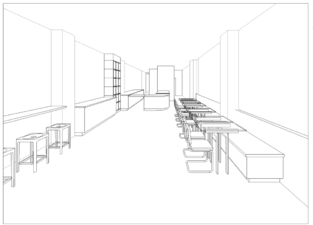We craft place and space. Clients come to Toner Architects for thoughtful approaches to urban transformations, building reinventions and custom homes — new builds, renovations and restorations.
RESIDENTIAL.
COMMERCIAL.
ADAPTIVE REUSE.
Toner Architects is known for Philadelphia vernacular architecture that inspires surprise and delight, pushes boundaries, and finds unique opportunities in every project. We are driven to shape spaces that create long term value through collaboration and innovation. Our culture fosters long-term relationships through a shared passion for design, architecture, and building.
FEATURED PROJECTS
CORE SERVICES
What does an architect do?
The typical answer to this question is “design buildings”. And to some extent, that’s true. But what is involved? Why is it worth paying someone to do this for me? I already know what I want my building to look like!
Rather than describe day-to-day tasks, here is a list of the four big-picture things architects do:
One: Listen and Share
An architect’s first job is to listen to their client’s wants and needs for the project. How big should the building be? What will it be used for? Will the needs change over time? The list of questions is endless, and the architect tailors the list to the situation.
It’s also important to understand the client’s limitations, and the limitations of the context the building will be built in. What’s the budget? What architectural styles does the client like? What are the zoning rules that will apply, and will they need to be broken? What is possible structurally?
While listening to the client’s input, the architect shares their own thoughts on what things might need further exploration, or on what approaches to similar challenges have succeeded or failed in the past. This early in the process, decisions are made that will have a profound effect on the final result, so it’s important to be thoughtful, share ideas freely, and think expansively so that the best possibilities rise to the surface.
Two: Synthesize and Envision
Next, the architect takes the ideas discussed above and starts to assemble them into various approaches to be investigated. There may be one primary idea, or there may be several. Working with the ideas and limitations, the architect begins to formulate some preliminary ideas to show to the client. These will likely include ideas that the client has thought of already, and some ideas that draw on the architect’s own experience.
The client and architect work together to review and refine the design ideas until they reach a final version that the client wants to move forward with. Whether or not this version looks like what the client first expected, this version has now been tested against a lot of other options and has been proven to be the best possible design for the project context.
Three: Organize and Document
Now the architect assembles the rest of the design team. This might involve engineers, specialty designers, and other experts. Each member of the design team uses their expertise and experience, as well as current codes, regulations, and rules to create drawings and other documentation for the construction team. The architect leads the design team and coordinates their work so that the final set of drawings and other paperwork is ready for the construction team.
Four: Observe and Adjust
When construction starts, the architect visits the project site to meet with the construction team and the client. During these visits, the architect has an opportunity to see the progress being made, and to answer questions from the construction team. These questions might require simple clarification of the drawings, or they might involve changes and adjustments that need to be made due to unforeseen conditions, changes in the budget, or changes in the client’s priorities. The architect, drawing on the history of the process (steps 1-3 above), as well as this new information, can make decisions for how to proceed to a successful end to the project.
Because every project is different, the process may vary, but generally this is what to expect:
- You are provided a Style Guide and Questionnaires to kick-off the interior design process. These help us understand your preferences right from the beginning, and will help us identify areas that we want to ask you more about.
- Initial meeting to review the items above and scope of work. This lays the groundwork for our initial design ideas.
- You will be provided with an initial look-book of ideas and preliminary selections, so we can get aligned with a design direction.
- We will refine the selections with your input. This is the “meat” of the design process.
- At the end of the design process we create a finish schedule, which will include a detailed list of all materials and locations and all other information needed for contractor ordering and installation. This helps nail down construction costs and last-minute panic during construction.
- During construction we’re available for site visits and contractor questions to help ensure the job is done correctly.
Why is it useful to have an architect involved during construction?
During the construction process, a lot can change. Sometimes this is due to concealed or unknown conditions that are encountered early in the project—large rocks in the ground where a foundation should go, or pre-existing structural damage that was hidden. Other times, it’s due to changes proposed by the contractor—a proposed change that might save money or time. Or it could be changes you propose yourself—your priorities have changed, or you get into the space and realize it doesn’t work for some reason.
We can analyze the situation to help you make good decisions about these changes by considering these new conditions, the project history, and the context of the applicable rules, regulations, and codes. In addition, we are likely to have prior experience with similar situations and can draw on that to provide good solutions.
Even if nothing changes, it’s useful for you to have someone familiar with the entirety of the project visiting regularly to see that the construction work is progressing as designed. If the contractor has questions or needs more information, we’re available to answer them. If the contractor has made unauthorized changes, this is our chance to see those and address them right away. This keeps things running smoothly and can help avoid problems before they arise.
START A CONVERSATION.
WHAT’S YOUR VISION?
Contact us to discuss your project, ask us questions and get to know us.
We’re a versatile firm working in a variety of capacities for a variety of clients. For private clients, we’re patient and thorough in crafting a new home. For commercial clients in the building community, we’re a force-multiplier in the Philadelphia region and in the city in-particular. In short, we’re here to collaborate with you. We’ll bring our best!




